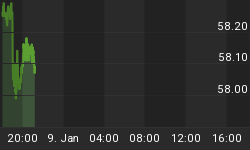We published a chart earlier in the year that showed Treasury Bonds were falling. Below is the chart updated thru May 28, 2009. Treasuries fell at the beginning of the year when the economy was still in freefall and have continued to decline despite the Federal Reserve's announcement that it would buy $300 billion worth of Treasuries. When an asset class goes parabolic and then falls, no matter how favorable the news is, it is likely that the bubble is popping. The housing bubble illustrates this phenomenon. At the end of the housing bubble most commentators knew that housing prices had overshot yet many remained optimistic that prices would simply correct with slower growth or only slight declines. Treasuries are again demonstrating that bubbles do not end by correcting sideways.

Central Banks Own Government Backed Debt, Not Other Forms of US Credit
There is a belief that falling Treasuries show that investment dollars are being reallocated from perceived low-risk Treasuries to riskier assets such as corporate bonds and equities. This trend, however, is not favorable for foreign central banks. Foreign central banks have huge US Dollar investments concentrated in Treasuries and mortgage-backed securities, which means they have two forms of risk associated with their holdings - the value of US Treasuries and the value of the US Dollar. Even though US corporate bond and equity prices have rallied, foreign central banks have had no benefit. Of late, these foreign holders have only suffered losses. These losses are the opposite of what our creditors grew accustomed to in the 1980s and 1990s. When the US slipped into recession, Alan Greenspan cut rates, which helped US growth resume and benefited the exports of foreign economies. At the same time, Treasuries and the US Dollar rose for nearly twenty years. It was this market action that reinforced central bank buying of Treasuries. Today we are on the verge of something quite different.
Historically, politicians and central banks have always acted the same. These people/institutions want to own assets that are rising because it makes them look smart while governments become fearful and sell assets that are falling. In the late 1990s, gold was doing poorly and the US Dollar and Treasuries were doing well. This explains why central banks sold gold and increased their holdings of US Dollar investments. As is now clear, every central bank is suffering sizable losses and as seen by the chart above this trend is beginning to spin out of control. Therefore, it should not be long until the US Dollar and Treasuries are treated in the same manner as gold was in the 1990s. This situation sets up for a severe reversal in central bank holdings.
It is now widely discussed that China has been stockpiling commodities. This has caused some investors to question the recent moves in commodity prices. Interestingly, this is what China has done for the last 20 years with Dollars yet no one recognizes the similarity. If China has been hoarding US Dollars (along with all other central banks) and now holds so much that they can not sell them, what does that say about the true value of the US Dollar?
The Real Bubble
Markets and investors still do not grasp the problems facing the US economy. The stock market bubble of the 1990s, the housing bubble and the more recent Treasury bubble were not the real bubbles. They were all offshoots of the main bubble, which is the US Dollar. That bubble is now bursting. The US Dollar is falling against every currency in the world. This is not because of quantitative easing or our weak economy, as many countries are facing similar problems, but rather because so many US Dollars are held abroad by individuals and central banks. For example, the US Dollar can fall against the Korean Won, despite Korea being an export-dependent economy because the central bank in Korea and so many Korean investors own US Dollars. As their holdings lose value, the temptation to sell increases dramatically. On the contrary, relatively few Americans own the Korean currency and thus there is virtually no selling pressure.
There is no doubt that the US benefited during the 1980s and 1990s from foreigners accumulating US Dollars. Interest rates, commodities, and consumer prices were kept low, which helped to propel asset prices higher. However, there is no such thing as a free lunch. Most informed people knew by the end of the housing market that the flurry of activity was unsustainable. However, where views differed was the extent of the damage of the correction. The key was understanding that housing was a bubble and bubbles end disastrously. Today most people know that the policies of the US government's stimulus and bailout plans, not to mention Social Security and Medicare, are problematic for the US fiscal situation and US Dollar yet have not accepted that the US Dollar is a bubble. When the market fully recognizes the Dollar bubble, the outcome will prove disastrous for anyone holding US Dollars.
The losses that foreigners are suffering on their US Dollar and Treasury holdings are rapidly accumulating. Even more so, the Fed is now trapped. The Fed was hoping to hold down Treasury rates by announcing the purchase of $300 billion of Treasuries. However, Treasuries are falling despite the Fed's intervention. If the Fed increases its buying there is no telling how far the US Dollar may fall. If the Fed does not increase its purchases, Treasuries may fall even further, sending home prices spiraling downwards. When combining the Fed's precarious position with recent fears about the credit rating of the US, the unlimited downside potential of all US assets is becoming clear even to the greatest of bulls. Despite waiting for so long for these events to unfold, it now seems as if the end is near.
















